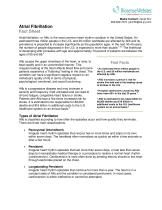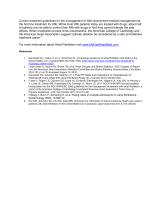
Catalog excerpts

V) Biosense Webster. PART OF THE ^ofctW01t«^ofm«OM FAMILY OF COMPANIES Media Contact: Janet Kim 909.839.7275 | jkim50@its.jnj.com Atrial Fibrillation Fact Sheet Atrial fibrillation, or Afib, is the most common heart rhythm condition in the United States. An estimated three million people in the U.S. and 20 million worldwide are affected by Afib and its prevalence is projected to increase significantly as the population ages. In the next 30-40 years, the number of people diagnosed in the U.S. is expected to more than double.1,2,3 The likelihood of developing Afib increases with age and approximately 70 percent of patients are between the ages of 65 and 85.4 Fast Facts • An estimated three million people in the U.S. and 20 million worldwide are affected by Afib. • Afib increases a person's risk for stroke five-fold and is the leading cause of strokes in the U.S. • Hospital admissions caused by Afib have risen 60% in the last 20 years.5 • Afib is estimated to be responsible for 88,000 deaths and $16 billion in additional costs to the U.S. healthcare system on an annual basis.6 Afib causes the upper chambers of the heart, or atria, to beat rapidly and in an uncontrolled manner. This irregular beating of the heart affects blood flow and some patients experience a "fluttering" feeling in the chest. The condition can have a significant negative impact on an individual's quality of life in terms of physical, psychological, emotional, and social functioning. Afib is a progressive disease and may increase in severity and frequency if left untreated and can lead to chronic fatigue, congestive heart failure or stroke. Patients with Afib face a five times increased risk for stroke. It is estimated to be responsible for 88,000 deaths and $16 billion in additional costs to the U.S. healthcare system on an annual basis.6 Types of Atrial Fibrillation Afib is classified according to how often the episodes occur and how quickly they terminate. There are three main classifications: • Paroxysmal (Intermittent) Irregular heart rhythm episodes that reoccur two or more times and stops on its own within seven days. The heartbeat often normalizes as quickly as within a few seconds or after a few hours. • Persistent Irregular heart rhythm episodes that last more than seven days, or last less than seven days but necessitates medical therapy or a procedure to restore a normal heart rhythm (cardioversion). Cardioversion is most often done by sending electric shocks to the heart through electrodes placed on the chest. • Longstanding Persistent Irregular heart rhythm episodes that continue for more than a year. The heart is in a constant state of Afib and the condition is considered permanent. In most cases, cardioversion is either ineffective or cannot be attempted.
Open the catalog to page 1
Symptoms & Risks Symptoms of Afib can range from a heightened awareness of a rapid heart rate to severe chest pain and fainting. Other symptoms include: • Anxiety • Rapid or irregular heartbeat • Weakness • Difficulty exercising • Debilitating pain • Sweating • Shortness of breath • Lightheadedness/dizziness • Chronic fatigue Treatment Options For patients requiring treatment to control their abnormal heart rhythm, there are a number of therapeutic options that may be considered. The appropriate treatment will depend on the underlying cause and type of Afib, existing symptoms and the...
Open the catalog to page 2
Current treatment guidelines for the management of Afib recommend medical management as the first line treatment for Afib. While most Afib patients today are treated with drugs, about half of patients are not able to control their Afib with drugs or find they cannot tolerate the side effects. When medication proves to be unsuccessful, the American College of Cardiology and the American Heart Association suggest catheter ablation be considered as a safe and effective treatment option.4 For more information about Atrial Fibrillation visit www.MyFastHeartBeat.com. References 1. Naccarelli GV,...
Open the catalog to page 3All Biosense Webster catalogs and technical brochures
-
PentaRay nav
2 Pages
-
CATALOGUE 2018
130 Pages
-
Ep procedure Documentation
2 Pages
-
CARTO® 3 System
3 Pages
-
C ARTO ® 3 System
3 Pages
-
AcuvNav? Catheter
4 Pages
-
AcuNav? Ultrasound Catheter
4 Pages
-
Webster® HIS Catheter
2 Pages
-
DecaNav? Catheter
3 Pages
-
PentaRay® NAV Catheter
6 Pages
-
Lasso® NAV Eco Catheter
6 Pages
-
ThermoCool® Catheters
4 Pages
-
SFOrderCard
2 Pages
-
ThermoCool ®
2 Pages
-
Nakagawa
6 Pages
-
COOLFLOW Pump
1 Pages
-
Tip Electrode Types
1 Pages
-
Fixed Curves
6 Pages
-
PENTARAY
1 Pages
-
WEBSTER Decapolar Catheter
1 Pages
-
WEBSTER Octapolar Catheter
1 Pages
-
HALO XP
1 Pages
-
ACUNAV brochure
4 Pages
-
CARTO RMT
4 Pages
-
EZ STEER
6 Pages
-
Stockert 70
1 Pages
-
THERMOCOOL
6 Pages
-
ACUNAV
4 Pages
-
CARTO XP EP
4 Pages
Archived catalogs
-
CATALOGUE 2015
140 Pages


















































































